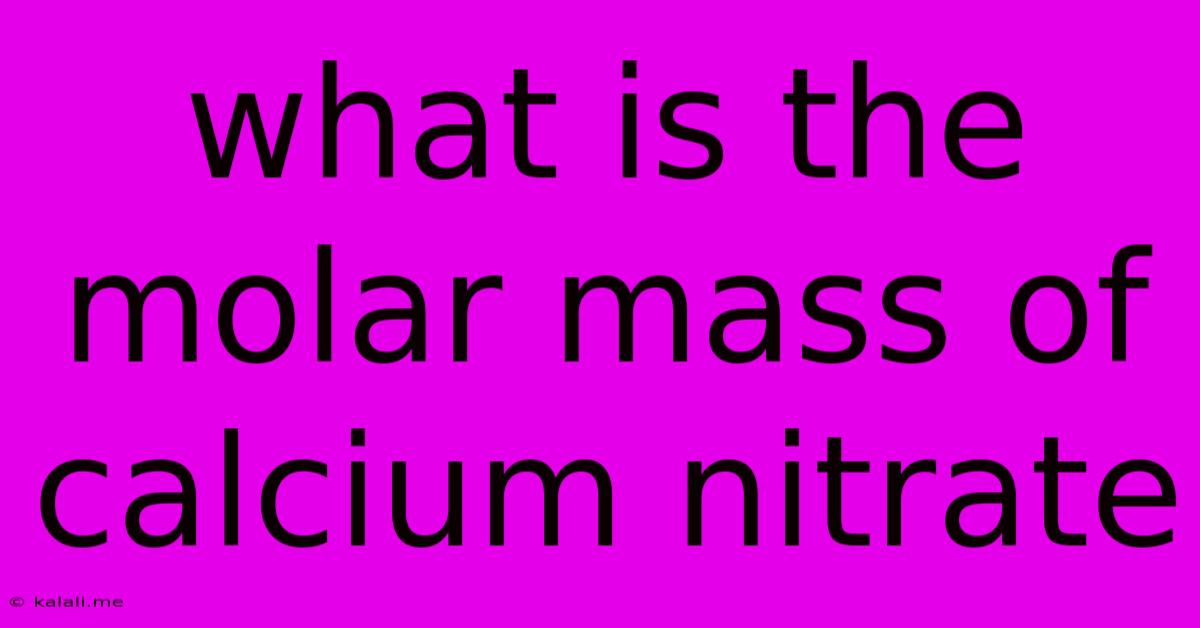What Is The Molar Mass Of Calcium Nitrate
Kalali
Jun 12, 2025 · 2 min read

Table of Contents
What is the Molar Mass of Calcium Nitrate? A Comprehensive Guide
Meta Description: Learn how to calculate the molar mass of calcium nitrate (Ca(NO₃)₂) and understand the fundamental concepts behind this important chemical calculation. This guide provides a step-by-step explanation and helpful tips.
Calculating the molar mass of a compound is a fundamental skill in chemistry. This comprehensive guide will walk you through the process of determining the molar mass of calcium nitrate, Ca(NO₃)₂, a common chemical compound used in various applications, including fertilizers and food preservation. We'll break down the process step-by-step, ensuring you understand the underlying principles.
Understanding Molar Mass
Before we delve into the calculation for calcium nitrate, let's briefly define molar mass. Molar mass is the mass of one mole of a substance. A mole is a unit of measurement in chemistry that represents Avogadro's number (approximately 6.022 x 10²³) of particles, whether they are atoms, molecules, or ions. The molar mass is expressed in grams per mole (g/mol).
Calculating the Molar Mass of Calcium Nitrate (Ca(NO₃)₂)
To calculate the molar mass of calcium nitrate, we need to consider the molar mass of each element present in the compound and the number of atoms of each element. Here's a step-by-step breakdown:
-
Identify the Elements: Calcium nitrate, Ca(NO₃)₂, contains three elements: calcium (Ca), nitrogen (N), and oxygen (O).
-
Determine the Number of Atoms of Each Element: From the chemical formula, we can see there's:
- 1 calcium atom (Ca)
- 2 nitrogen atoms (N) (because of the subscript 2 outside the parentheses)
- 6 oxygen atoms (O) (2 nitrogen atoms x 3 oxygen atoms per nitrate ion)
-
Find the Atomic Mass of Each Element: You can find the atomic mass of each element on a periodic table. Approximate atomic masses are:
- Calcium (Ca): 40.08 g/mol
- Nitrogen (N): 14.01 g/mol
- Oxygen (O): 16.00 g/mol
-
Calculate the Total Mass: Now, we multiply the atomic mass of each element by the number of atoms of that element present in the compound and then sum up the results:
(1 Ca atom × 40.08 g/mol) + (2 N atoms × 14.01 g/mol) + (6 O atoms × 16.00 g/mol) = 164.10 g/mol
Therefore, the molar mass of calcium nitrate (Ca(NO₃)₂) is approximately 164.10 g/mol.
Applications and Importance of Molar Mass Calculations
Knowing the molar mass of calcium nitrate and other compounds is crucial in various chemical calculations, including:
- Stoichiometry: Determining the amounts of reactants and products in chemical reactions.
- Solution Preparation: Preparing solutions with specific concentrations.
- Titrations: Analyzing the concentration of unknown solutions.
- Chemical Analysis: Determining the composition of a substance.
Understanding molar mass is a fundamental concept in chemistry with wide-ranging applications in various scientific fields and industries. By mastering this calculation, you'll have a stronger foundation for tackling more advanced chemical concepts.
Latest Posts
Latest Posts
-
What Is The Opposite Of Traditional
Jun 13, 2025
-
What Does Xxvii Mean In Roman Numerals
Jun 13, 2025
-
What Is A Multiple Of 13
Jun 13, 2025
-
Does Cal Poly Slo Require Sat
Jun 13, 2025
-
Least Common Multiple 5 6 7
Jun 13, 2025
Related Post
Thank you for visiting our website which covers about What Is The Molar Mass Of Calcium Nitrate . We hope the information provided has been useful to you. Feel free to contact us if you have any questions or need further assistance. See you next time and don't miss to bookmark.